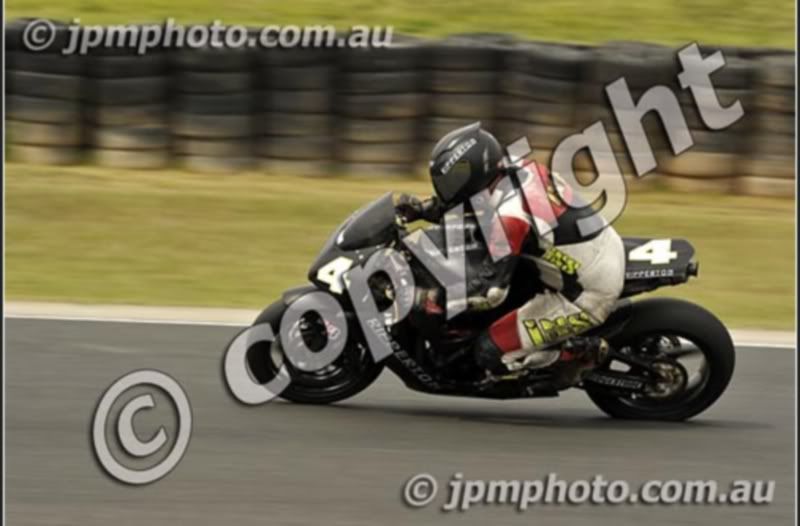I've quoted this from Jonno's EPICSuspension Setup page here in case oThers wanT To learn Too.
viewtopic.php?f=21&t=24596
Really good facts and science for learning to choose correct tyre pressures.
------------------------------------------------------------------------------------------------------------
Tyre Pressure:
You'll get a lot of opinions on what tyre pressure to run, but the correct tyre pressure for you is not a matter of polling other rider's opinion. Here are the basics you'll need to decide for yourself. Dennis Smith of Dunlop's Sport Tyre Services recommends an increase of two to four pounds in front tyres and six to eight in the rear. While the most scientific means of determining if a particular pressure is the use of a pyrometer to assess whether the rubber has reached the manufacturer's recommended temperature, charting the pressure increase of a tyre after track sessions will give a good impression of how hard a tyre is working.
Stamped on the outside of many of your tyres is a recommended tyre pressure range. (At least an upper limit.) For longest tyre life it is my recommendation that you strive to keep them at the higher limit of those recommendations (regardless of what your motorcycle owner's manual might say to the contrary.) Further, this pressure should be determined while the tyres are cold - meaning, have not been used for a couple of hours.
Start with the bike manufacturer's recommendation in the owners manual or under-seat sticker. This is the number they consider to be the best balance between handling, grip and tyre wear. Further, if you're running alloy wheels on poor pavement, consider adding 2 psi to the recommended tyre pressure just to reduce the likelihood of pothole damage. Just as you would for a car, increase the pressure 2 psi or so for sustained high speed operation (or 2-up riding) to reduce rolling friction and casing flexing.
In order to get optimum handling a tyre has to get to its optimum temperature, which is different for each brand of tyre. Most of us don't have the equipment needed to measure tyre temperature directly so we measure it indirectly by checking tyre pressure since tyre pressure increases with tyre temperature. Tyre temperature is important to know because too much flexing of the casing of an under-inflated tyre for a given riding style and road will result in overheating resulting in less than optimum grip. Over-pressurizing a tyre will reduce casing flexing and prevent the tyre from getting up to the optimum operating temperature and performance again suffers. Sliding and spinning the tyres also increase tyre temperatures from friction heating.
A technique for those wanting to get the most out of their tyres on the street is to use the 10/20% rule.
First check the tyre pressure when the tyre is cold. Then take a 30-40 minute ride on your favorite twisty piece of road to get your tyre temperature up, then measure the tyre pressure immediately after stopping.
If the pressure has risen less than 10% on the front or less than 20% on the rear, the rider should remove air from the tyre (to increase heating affect of carcass flex). So for example, starting at a front tyre pressure of 32.5 psi should bring you up to 36 psi hot. Once you obtain this pressure increase for a given rider, bike, tyre, road and road temperature combination, check the tyre pressure again while cold and record it for future reference.
Each manufacturer is different. Each tyre model is different.
A tyre design that runs cooler needs to run a lower pressure (2-3 psi front) to get up to optimum temperature. Remember carcass flex to generate additional heat.
The rear tyre runs hotter than the front tyre on both road and track. So the rear tyre cold-to-hot increase is greater.
Dropping air pressure has the additional side effect of scrubbing more rubber area, and can additionally add more traction at the cost of a little stability
As an example for aprilia RSV Mille recommended starting temperatures for road use are.
Front Tyre 34.8 deg. Cold which in turn should be approximately 37.5 -38.5 deg Hot (3-4psi increase)
Rear Tyre 39.4 deg Cold which in turn should be approximately 45-47 deg Hot (7-9psi increase)
For the track you'll have to drop the cold tyre pressures an additional 10/20%. Track operation will get tyres hotter (increasing the cold-to-hot pressure range) so starting at say 32/30 psi now should bring you up to the same temperature (and pressure) that 35/39 psi gave you for the street.
Since track riding put tremendous stresses on a tyre the tyre heats up more than if it was on the street. run at a racetrack, unless of course you're running a race tyre. The lower the tyre pressure the more the tyre deforms. The more the tyre deforms, the more friction there is between the tyre and the road surface. The more friction, the more heat. The more heat, the greater the opportunity the tyre has to regenerate itself by shedding the 'used' layers of rubber (to a point). This deformation of the tyre also creates a bigger contact patch at the cost of a little stability.
When you are accounting for your riding style and the way different days, streets, tracks can be accounted for. All bikes will have different characteristics which means my starting riding temperature is different than yours.
Additionally with the colder months of the year tyre pressures and the effect of temperature can greatly affect the overall pressure.
Time and outside temperature effect the pressure within your tyres. It is NORMAL for a tyre to lose about 1 pound per square inch (psi) per month. Outside temperatures affect your tyre pressure far more profoundly, however. A tyre's pressure can change by 1 psi for every 10 degrees Fahrenheit of temperature change. As temperature goes, so goes pressure.
For example, if a tyre is found to have 38 psi on an 80-degree mid-summer day, it could lose enough air to have an inflation pressure of 26 psi on a 20-degree day six months later. This represents a loss of 6 psi over six months and an additional loss of 6 psi due to the 60 degree temperature reduction.
At 26 psi, your tyre is severely under inflated and dangerous!
What is being illustrated here is that you MUST check your tyre pressure on a regular basis (about once a week is reasonable) and to be particularly aware of it on cold days
Reference of James R. Davis, sportsrider.com, Larry Kelly mad-ducati.com
Suspension stroke
A sportbike should normally not use its full suspension stroke, although on some circuit one or two big bumps or hollows can cause the suspension to bottom. Also landing of front wheel after wheelies can cause excessive use of the front fork stroke. If suspension bottoms in big bump or hollow, it should not automatically mean that the suspension should be set more hard. However, if suspension bottoms at the place were the maximum grip is essential the tyre cannot create the best traction, because it also has to perform as spring. Adjusting the setting is necessary. During every riding session the suspension stroke should be carefully checked. When tyre grip and lap times improve, the suspension has a harder job. So, setting must be set harder. On the opposite, when it starts raining tyre grip and lap times go down, in that case a softer setting should be applied.



